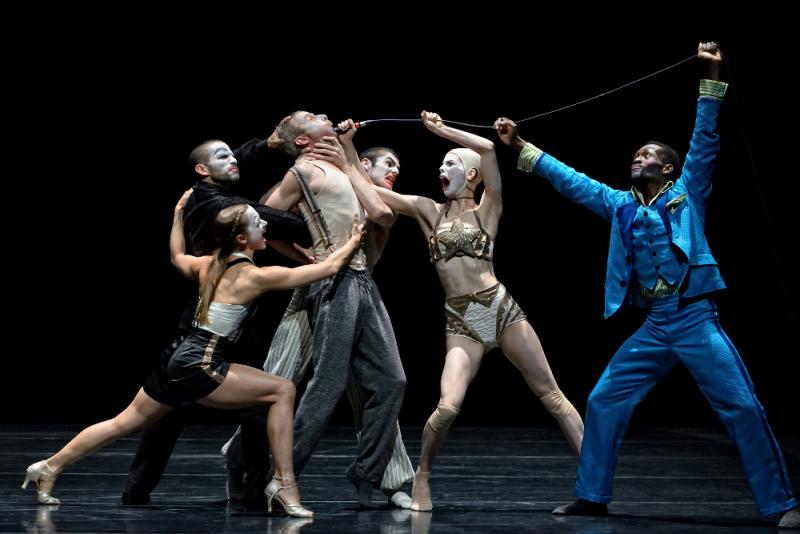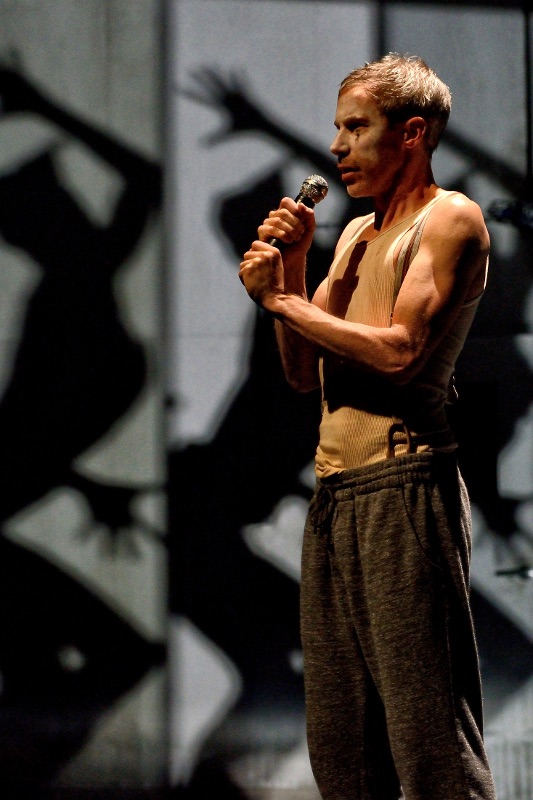Betroffenheit, Sadler's Wells/Ballet BC, Birmingham Hippodrome | reviews, news & interviews
Betroffenheit, Sadler's Wells/Ballet BC, Birmingham Hippodrome
Betroffenheit, Sadler's Wells/Ballet BC, Birmingham Hippodrome
Choreographer du jour Crystal Pite heads up two impressive Canadian cultural offerings

I could tell you what the German word "Betroffenheit" means by giving a dictionary definition, etymology and connotations and so on. But I won't, because this dance-drama hybrid by Jonathan Young and Crystal Pite is precisely not about pinning down definitions or making sense through words in a descriptive, iterative sort of way, but about capturing feelings or states of being in a much more metaphorical, experiential, immersive way.
But it started from a very specific and personal experience. In that sense, Betroffenheit describes a state Jonathon Young experienced after his teenage daughter, niece and nephew were killed in a fire in 2009. The genius of both Young and Pite is that they (together with their respective troupes Electric Theatre Company and Kidd Pivot) were able to transform one person's appalling experience into a superbly crafted show, abstracting and universalizing aspects of trauma, addiction and recovery without losing the spark of truth.
 It's not an easy watch by any means, particularly the first section which appears to address post-traumatic stress disorder, and in which the protagonist (played by Young himself, pictured right) battles disembodied voices in a dingy, claustrophobic room which seems to be vulnerable to invasion without offering the possibility of escape. Replaying a traumatic event and struggling to cope, we see him running, cowering, writhing, and conversing with remote interlocutors who might be therapists or internal demons. One seems to resolve itself into the voice of addiction and leads into the second section, which is structured by the nifty metaphor of "showtime" for substance abuse, and sees Young joined by five dancers in a cabaret which gradually descends from the high of glitz and amusement to the low of incapacity, sickness and chaos.
It's not an easy watch by any means, particularly the first section which appears to address post-traumatic stress disorder, and in which the protagonist (played by Young himself, pictured right) battles disembodied voices in a dingy, claustrophobic room which seems to be vulnerable to invasion without offering the possibility of escape. Replaying a traumatic event and struggling to cope, we see him running, cowering, writhing, and conversing with remote interlocutors who might be therapists or internal demons. One seems to resolve itself into the voice of addiction and leads into the second section, which is structured by the nifty metaphor of "showtime" for substance abuse, and sees Young joined by five dancers in a cabaret which gradually descends from the high of glitz and amusement to the low of incapacity, sickness and chaos.
Pite's perfect theatrical instinct is amply displayed in this section, which in less able hands could easily seem gauche or laboured, and she shows off the incredible capabilities of her dancers with a panoply of dance styles (tap, jazz, ballroom) and seriously demanding choreography - all of which they execute with the effortless fluidity that for me is a Pite trademark. Another Pite trademark is a gestural language delivered with the precise articulation and timing of words in a sentence, a kind of speaking with the body, which is here cleverly set to the recorded script in such a way that dance and words can "talk" in tandem. It's surprisingly effective: even though listening to the repeated, fragmented phrases of Young's script is hard work at times, I found the mostly danced final section less interesting, at least until the splendid Jermaine Spivey's beautiful crowning solo, which suggested better than words could the gentle possibility of recovery.
Ballet BC have life-giving showmanship, a conscious, theatrical confidence
This powerful and imaginative piece was the second all-Canadian cultural offering I saw in a fortnight. The other, just as strong as Betroffenheit, was a triple bill by Ballet BC which closed the International Dance Festival Birmingham last month and also featured Pite's choreography, alongside pieces by the company's artistic director Emily Molnar and Israeli choreographer Sharon Eyal.
Pite's Solo Echo, created on Nederlands Dans Theater in 2012, has traits now familiar from her other work: the doubled structure of Tempest Replica, groups moving with unsettling organic unity as in Polaris, even a literary framework using second-person narration. In A Picture of You Falling, the latter was provided by a short story-style voiceover written by Pite herself, in Solo Echo it's "Lines for Winter" by Canadian-born poet Mark Strand, printed in the programme though not referred to explicitly in the dance. Strand is a poet of introspection and the tough, unsentimental kind of loneliness that seeks out cold nights and icy starlight in order to make peace with mortality. In Solo Echo, Pite adds warmth to a Strand-ian vision by using music from Brahms's two cello sonatas, the Allegro non troppo from Op. 38 and the Adagio affetuoso from Op. 99. Both movements yearn, the earlier Op.38 in tempestuous bursts of anger, the much later Op.99 with a more studied elegiac patience: against both Pite creates her usual rich, emotional world by juxtaposing the lonely duet of the first movement against the togetherness of the second.
Emily Molnar's 16+ a room was more conventional, being essentially a pure dance piece with minimalist costumes and an electronic score, but Molnar does it several cuts above the ordinary standard, presenting a sustained, technically analytical symphony in forms, whose 27-minute run time is densely packed with ideas and unremitting demands on the dancers. They dance with the speed and extension now familiar from Wayne McGregor's work with the Royal Ballet, but in a far greater range of movements. Molnar, who like Crystal Pite is a Ballet Frankfurt alumna, like Pite spikes her Forsythe-inspired deconstructed classicism with B-boy and martial arts references that ask for open hips, twisting, floor-work, and running.
Sharon Eyal comes from a different choreographic tradition to Molnar and Pite: the radical, creative world of Israel's Batsheva Dance Company under long-term artistic director Ohad Naharin. The dance training pioneered by Naharin is called Gaga; any resemblance to Mother Monster is, we presume, purely coincidental, and yet Eyal's Bill called Lady Gaga (in her Bad Romance phase) firmly to mind, along with all those other weird, wired pop geniuses who burst open boxes and closets with their showmanship: Bowie, Freddy Mercury, Prince. Bill has the lavish oddness of Gaga and Ziggy Stardust - the dancers look like aliens in creepily skin-like catsuits and silver contact lenses - but also the triumphant, stadium-filling exhilaration of something like "Bohemian Rhapsody", or (Eyal's fellow Batsheva alumnus) Itzik Galili's A Linha Curva, whose exuberant pelvis-wiggling Eyal's Bill makes more fey and brilliant by slowing it down.
Ballet BC are more than strong enough to show off these three intense, demanding pieces (biceps and six-packs are de rigueur in a troupe so obviously physically elite that they could probably waltz through SAS basic training), but they have life-giving showmanship too: a conscious, theatrical confidence that says, "Just sit back and relax - we're going to show you something good." On the evidence of both their bill and Young and Pite's Betroffenheit, I'd trust any Canadian dancer who said that.
rating
Explore topics
Share this article
The future of Arts Journalism
You can stop theartsdesk.com closing!
We urgently need financing to survive. Our fundraising drive has thus far raised £33,000 but we need to reach £100,000 or we will be forced to close. Please contribute here: https://gofund.me/c3f6033d
And if you can forward this information to anyone who might assist, we’d be grateful.

Subscribe to theartsdesk.com
Thank you for continuing to read our work on theartsdesk.com. For unlimited access to every article in its entirety, including our archive of more than 15,000 pieces, we're asking for £5 per month or £40 per year. We feel it's a very good deal, and hope you do too.
To take a subscription now simply click here.
And if you're looking for that extra gift for a friend or family member, why not treat them to a theartsdesk.com gift subscription?
more Dance
 Help to give theartsdesk a future!
Support our GoFundMe appeal
Help to give theartsdesk a future!
Support our GoFundMe appeal
 First Person: singer-songwriter Sam Amidon on working in Dingle with Teaċ Daṁsa on 'Nobodaddy'
Michael Keegan-Dolan’s mind-boggling total work of art arrives at Sadlers Wells this week
First Person: singer-songwriter Sam Amidon on working in Dingle with Teaċ Daṁsa on 'Nobodaddy'
Michael Keegan-Dolan’s mind-boggling total work of art arrives at Sadlers Wells this week
 Akram Khan, GIGENIS, Sadler’s Wells review - now 50, Khan returns to his roots
The dancer-choreographer goes epic in a show that unites South Asian dance styles
Akram Khan, GIGENIS, Sadler’s Wells review - now 50, Khan returns to his roots
The dancer-choreographer goes epic in a show that unites South Asian dance styles
 Maddaddam, Royal Ballet review - superb dancing in a confusing frame
Wayne McGregor's version of Margaret Atwood's dystopia needs a clearer map
Maddaddam, Royal Ballet review - superb dancing in a confusing frame
Wayne McGregor's version of Margaret Atwood's dystopia needs a clearer map
 Pina Bausch’s The Rite of Spring/common ground[s], Sadler’s Wells review - raw and devastating
Returning dancers from 13 African countries deliver celebrated vision with blistering force
Pina Bausch’s The Rite of Spring/common ground[s], Sadler’s Wells review - raw and devastating
Returning dancers from 13 African countries deliver celebrated vision with blistering force
 Legacy, Linbury Theatre review - an exceptional display of black dance prowess
An all-too-fleeting celebration of black and brown ballet talent that demands a reprise
Legacy, Linbury Theatre review - an exceptional display of black dance prowess
An all-too-fleeting celebration of black and brown ballet talent that demands a reprise
 National Ballet of Canada, Sadler's Wells review - see this, and know what dance can do
Yet again, Crystal Pite proves herself a ferocious creative force, alongside fellow Canadian exports James Kudelka and Emma Portner
National Ballet of Canada, Sadler's Wells review - see this, and know what dance can do
Yet again, Crystal Pite proves herself a ferocious creative force, alongside fellow Canadian exports James Kudelka and Emma Portner
 Nobodaddy, Teaċ Daṁsa, Dublin Theatre Festival review - supernatural song and dance odyssey
Michael Keegan-Dolan’s genius guides us through death, separation and loss
Nobodaddy, Teaċ Daṁsa, Dublin Theatre Festival review - supernatural song and dance odyssey
Michael Keegan-Dolan’s genius guides us through death, separation and loss
 Alice's Adventures in Wonderland, Royal Ballet review - big, bold and ultimately brash
It may be box-office gold, but Christopher Wheeldon's adaptation fails to find a beating heart down the rabbit hole
Alice's Adventures in Wonderland, Royal Ballet review - big, bold and ultimately brash
It may be box-office gold, but Christopher Wheeldon's adaptation fails to find a beating heart down the rabbit hole
 Resurgence, London City Ballet, Sadler’s Wells review - the phoenix rises yet again
A new 14-strong company reviving a much-loved name is taking ballet to smaller theatres
Resurgence, London City Ballet, Sadler’s Wells review - the phoenix rises yet again
A new 14-strong company reviving a much-loved name is taking ballet to smaller theatres
 The Mad Hatter's Tea Party, ZooNation, Linbury Theatre review - a joyous celebration of differentness
Kate Prince's hip hop take on Lewis Carroll is energetic, charming and moving by turns
The Mad Hatter's Tea Party, ZooNation, Linbury Theatre review - a joyous celebration of differentness
Kate Prince's hip hop take on Lewis Carroll is energetic, charming and moving by turns

Add comment